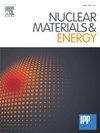Integrated modelling of lithium transport and radiation under a liquid lithium divertor on EAST
IF 2.3
2区 物理与天体物理
Q1 NUCLEAR SCIENCE & TECHNOLOGY
引用次数: 0
Abstract
The edge transport and core accumulation of lithium (Li) impurity under a liquid Li divertor on EAST have been investigated by the EMC3-EIRENE and STRAHL codes, respectively. At the edge region, the Li density distribution and power dissipation derived from divertor targets have been simulated by EMC3-EIRENE modeling. At the core region, the ONETWO and TGYRO codes are used to calculate the Li transport coefficients for STRAHL modeling, which is implemented through the OMFIT framework. At the core–edge transition region ( = 0.95 ∼ 1.02, is the normalized poloidal flux coordinate), the representative distribution of ion density is used for the comparison between EMC3-EIRENE and STRAHL modellings, which can achieve a reasonable agreement between two codes. On this basis, the Li-ion core density and radiation distributions have been analyzed by STRAHL modeling, which indicates there exist two radiation peaks located at the magnetic axis and = 1.01. The impacts of Li radiation on H-L back transition have been studied by Martin’s threshold power scaling law (Martin et al 2008J Phys Conf Ser 123 012033). The core radiation of lithium has a limited impact on the operation regime of EAST. Even for the maximum lithium effective sputtering coefficient of 0.1 used in the current study, it is still insufficient to cause H-L back transition.
求助全文
约1分钟内获得全文
求助全文
来源期刊

Nuclear Materials and Energy
Materials Science-Materials Science (miscellaneous)
CiteScore
3.70
自引率
15.40%
发文量
175
审稿时长
20 weeks
期刊介绍:
The open-access journal Nuclear Materials and Energy is devoted to the growing field of research for material application in the production of nuclear energy. Nuclear Materials and Energy publishes original research articles of up to 6 pages in length.
 求助内容:
求助内容: 应助结果提醒方式:
应助结果提醒方式:


